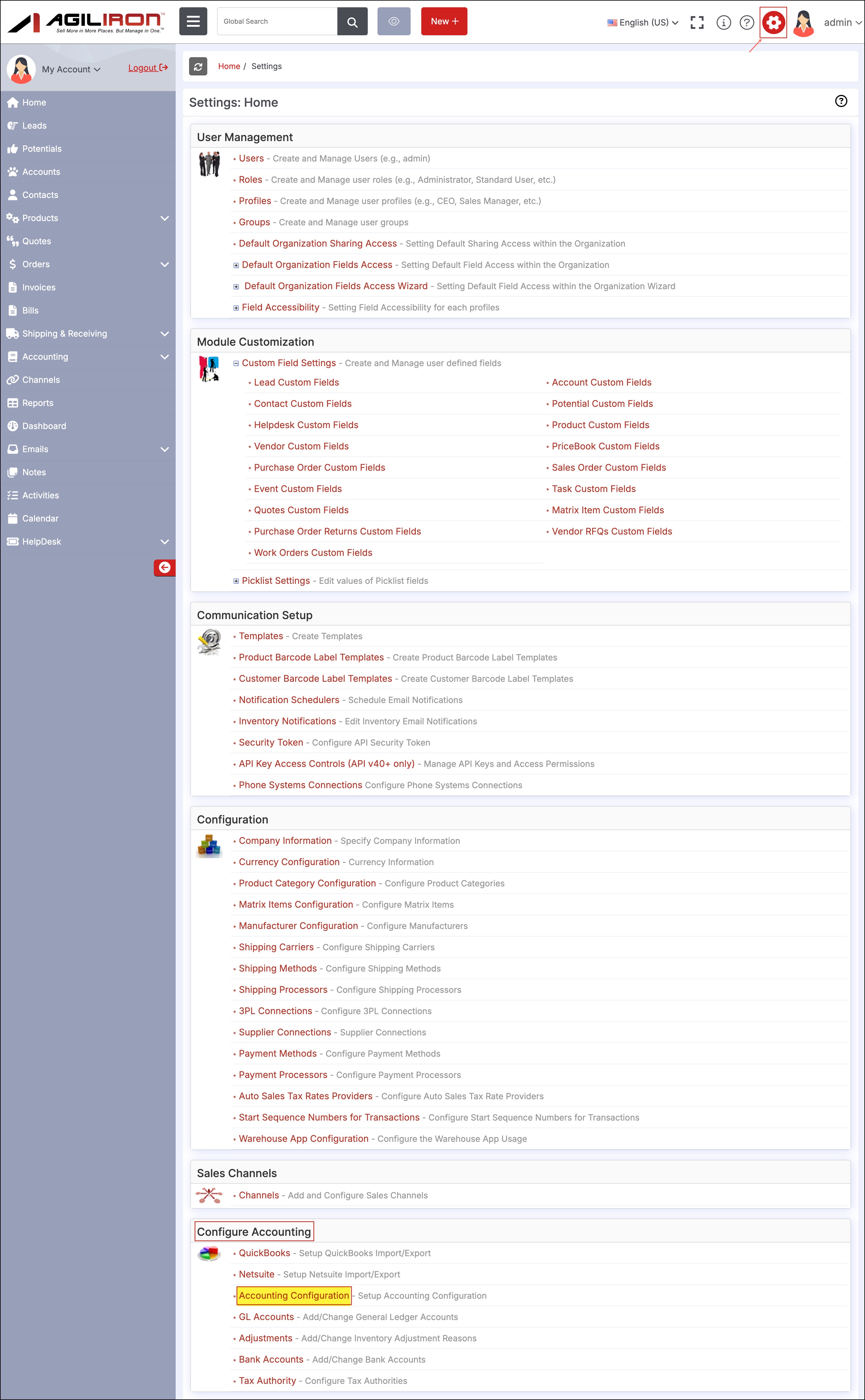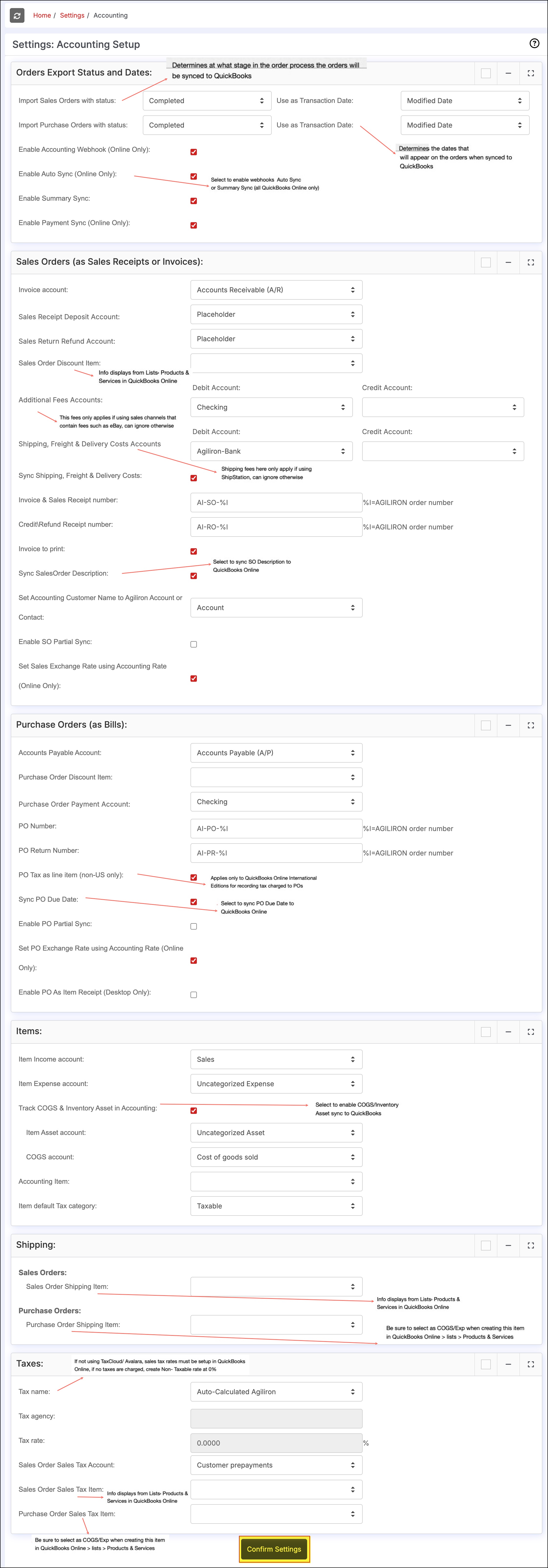Configuration of Integration Parameters
Once the user has completed the "Set Up" and "Match" processes, the user can then go to the "Configure" tab to complete the QuickBooks setup. In this step, the user designates the various default behaviors for exporting transactions into QuickBooks, as shown below.
Navigate to Settings -> Accounting Configuration to begin.

Important:
Use the "Import Sales/Purchase Orders with status" fields to select the orders to export to QuickBooks. "Created" refers to all orders existing in the Agiliron system from any sales channel - sales orders that are not "Paid" would be exported as "Invoices" - use this only if you expect to process Invoices & Payments through QuickBooks. Note: If managing Invoices in QuickBooks Online, we can enable the webhooks feature that allows the invoices in Agiliron to be marked paid when the invoice is paid in QuickBooks Online. This feature is not turned on by default. Please email [email protected] to have it turned “on”. "Completed" refers to only orders that are completed transactions (Paid & Shipped) - sales orders are exported to QuickBooks as "Sales Receipts" if this status is selected. For Purchase Orders, selecting "Received" exports purchase orders as "Bills" to QuickBooks. Note: When managing Payables in QuickBooks Online, if a vendor invoice is marked Paid in QuickBooks Online, we can enable the webhooks feature that allows the PO to be marked paid in Agiliron. This feature is not turned on by default. Please email [email protected] to have it turned “on”. "Use As Transaction Date" determines the date displayed on the orders when synced.

The various fields and their purpose and use are summarized below:
-
Orders Export status and dates
-
Import Sales Orders with status
-
Purpose: Sales Orders with this Status are exported from Agiliron
-
Options: Completed, Created, Invoiced, Paid, Shipped
-
Default: Completed
-
Import Purchase Orders with status
-
Purpose: Purchase Orders with this Status are exported from Agiliron
-
Options: Completed, Ordered, Shipped, Received, Invoiced, Paid
-
Default: Completed
-
Use as Transaction Date
-
Purpose: Transaction Date specified as the Sales and Purchase orders are exported from Agiliron
-
Options: Created Date, Modified Date, Paid Date
-
Default: Modified Date
-
Enable QuickBooks Webhook (QuickBooks Online Only)
-
Purpose: Turn on webhooks for notifications on Invoice or Bill Payments from QuickBooks Online to Agiliron
-
Options: On/Off
-
Default: Off
-
Enable Auto Sync (QuickBooks Online Only)
-
Purpose: Enable automatic sync of Sales/Purchase Orders, Sales Returns and Inventory Adjustments. Sync occurs every hour.
-
Options: On/Off
-
Default: Off
-
Enable Summary Sync (QuickBooks Online Only)
-
Purpose: Enables sync of transactions as summaries instead of individual transactions (for example, Retail POS or Amazon/eBay sales).
-
Options: On/Off
-
Default: Off
-
Sales Orders (as Sales Receipts or invoices)
-
Invoice account
-
Purpose: Default "Accounts Receivable" Account
-
Options: "Accounts Receivable" GL Accounts
-
Default: "Accounts Receivable"
-
Sales Receipt Deposit Account
-
Purpose: Default account for Deposit of Sales Receipt $
-
Options: Populates from "Settings > GL Accounts > Asset Accounts" and "Settings > Bank Accounts"
-
Default: First item in list
-
Sales Return Refund Account
-
Purpose: Default account from which Return refunds are paid out
-
Options: Populates from "Settings > GL Accounts > Asset Accounts," and "Settings > Bank Accounts" and "Credit Card Accounts"
-
Default: First item in list
-
Sales Order Discount Item
-
Purpose: QuickBooks Item for Discounts
-
Options: Populates from "Settings > QuickBooks > Setup" Item list filtered for Discount Items
-
Default: First item in list
-
Additional Fees Accounts - Debit
-
Purpose: Default account from which Additional Fees (e.g. eBay Fees) are paid out
-
Options: Populates from "Settings > GL Accounts > Asset Accounts" and "Settings > Bank Accounts" and "Credit Card Accounts"
-
Default: First item in list
-
Additional Fees Accounts - Credit
-
Purpose: Default account to which Additional Fees are recorded
-
Options: Populates from "Settings > GL Accounts > COGS Accounts" and "Settings > GL Accounts > Expense Accounts"
-
Default: First item in list
-
Shipping, Freight & Delivery Costs Accounts - Debit
-
Purpose: Default account from which Shipping Costs are paid out
-
Options: Populates from "Settings > GL Accounts > Asset Accounts" and "Settings > Bank Accounts" and "Credit Card Accounts"
-
Default: First item in list
-
Shipping, Freight & Delivery Costs Accounts - Credit
-
Purpose: Default account to which Shipping Costs are recorded
-
Options: Populates from "Settings > GL Accounts > COGS Accounts" and "Settings > GL Accounts > Expense Accounts"
-
Default: First item in list
-
Sync Shipping, Freight, & Delivery Costs
-
Purpose: Sync Shipping, Freight, & Delivery Costs from orders shipped via ShipStation. Cost(s) will display in QuickBooks for each individual order.
-
Options: On/Off
-
Default: Off
-
Invoice & Sales Receipt number
-
Purpose: Invoice Number sent to QuickBooks - %I is replaced by Agiliron Sales Order Number where I is an integer
-
Options: AI-SO-%I
-
Default: AI-SO-%I
-
Invoice to print
-
Purpose: Mark invoices for printing (to batch print new invoices)
-
Options: On/Off
-
Default: On
-
Sync SalesOrder Description
-
Purpose: Sync the Sales order Description filed to QuickBooks
-
Options: On/Off
-
Default: Off
-
Purchase Orders (as Bills)
-
Accounts Payable Account
-
Purpose: Default "Accounts Payable" Account
-
Options: "Accounts Payable" GL Accounts
-
Default: "Accounts Payable"
-
PO Discount (Contra) Account
-
Purpose: Default account to which PO discounts are recorded
-
Options: Populates from "Settings > GL Accounts > COGS Accounts" and "Settings > GL Accounts > Expense Accounts"
-
Default: First item in list
-
Purchase Order Payment Account
-
Purpose: Used when POs are synched from Agiliron to QuickBooks Online that include partial/full payments. Needs to be set to the Account that will be used for Payment of Bills in QuickBooks Online.
-
Options: Populates from Bank Account in QuickBooks Online.
-
Default:First item in list
-
PO Number
-
Purpose: PO Number sent to QuickBooks - %I is replaced by Agiliron Purchase Order Number where I is an integer
-
Options: AI-PO-%I
-
Default: AI-PO-%I
-
PO Tax as line item (non-US Only)
-
Purpose: This is for QuickBooks Online International customers only, allows syncing of PO Tax as a line item for tax purposes (ie: GST)
-
Options: On/Off
-
Default: Off
-
Sync PO Due Date
-
Purpose: Allows syncing of PO Due date to QuickBooks
-
Options: On/Off
-
Default: Off
-
Enable PO Partial Sync (QuickBooks Online Only)
-
Purpose: Allows syncing of partially received POs to QuickBooks
-
Options: On/Off
-
Default: Off
-
Items
-
Item Income account
-
Purpose: Default Income account for Sales
-
Options: Populates from "Settings > GL Accounts > Income Accounts"
-
Default: First item in list
-
Item Expense account
-
Purpose: Default Expense account for Service Product Sales Costs
-
Options: Populates from "Settings > GL Accounts > Expense Accounts"
-
Default: First item in list
-
Track COGS & Inventory Asset in QuickBooks
-
Purpose: Turn On/Off COGS, Inventory Asset Journal entries in QuickBooks when transactions are exported. Uses Unit Cost values as in Agiliron.
-
Options: On/Off
-
Default: On
-
Item Asset account
-
Purpose: Default Inventory Asset account for recording inventory changes on Sales
-
Options: Populates from "Settings > GL Accounts > Asset Accounts"
-
Default: First item in list
-
COGS account
-
Purpose: Default COGS account for recording cost of Sales
-
Options: Populates from "Settings > GL Accounts > COGS Accounts"
-
Default: First item in list
-
Accounting Item
-
Purpose: Default QuickBooks Item for Sales
-
Options: Populates from "Settings > QuickBooks > Setup" item list (displays "Non-Inventory Part" and "Service" items from QuickBooks).
-
Default: First item in list
-
Item default Tax Category
-
Purpose: Default Tax Status for Sales
-
Options: Taxable/Non-Taxable
-
Default: Taxable
-
Shipping
-
Sales Order Shipping Item
-
Purpose: Default account for Shipping Charges assessed to customers on Sales
-
Options: Populates from "Settings > QuickBooks > Setup" item list (displays "Non-Inventory Part" and "Service" items from QuickBooks).
-
Default: First item in list
-
Purchase Order Shipping Item
-
Purpose: Default account for Shipping Charges assessed on Purchase Orders from the Vendor
-
Options: Populates from "Settings > QuickBooks > Setup" item list (displays "Non-Inventory Part" and "Service" items from QuickBooks).
-
Default: First item in list
Taxes Tax name Purpose: Default Tax Authority for order export to QuickBooks if the Tax Authority is not selected in Sales Order Options: Populates from "Settings > Tax Authority" Default: First item in list Tax agency Purpose: Automatically set based on Tax name selection above Tax rate Purpose: Automatically set based on Tax name selection above Sales Order Sales Tax Account Purpose: Default Account to record Sales Tax only when TaxCloud or Avalara are connected Options: Populates from "Settings > GL Accounts" , filters for "Other Current Liabilities" accounts Default: First item in list Sales Order Sales Tax Item Purpose: Default Account to record Sales Tax from Orders Options: Populates from "Settings > QuickBooks > Setup" item list (displays "Non-Inventory Part" and "Service" items from QuickBooks). Default: First item in list Purchase Order Sales Tax Item Purpose: Default Account to record Sales Tax from Purchase Orders Options: Populates from "Settings > QuickBooks > Setup" item list (displays "Non-Inventory Part" and "Service" items from QuickBooks). Default: First item in list
Click the "Confirm Settings" button to save any changes made. This now completes the setup for QuickBooks.
Note: This is a one-time setup and does not need to be revisited unless the user makes changes to the accounting setup in QuickBooks. With this setup completed, you will be able to sync the following entities to QuickBooks from Agiliron on an ongoing basis:
- Sales Orders - as Sales Receipts or Invoices (depending on whether they have been Paid or not)
- Purchase Orders - as Bills (so you could then pay your vendors from QuickBooks)
- Sales Returns - as Credit Memos
- Various Journal Entries - for COGS, Inventory Asset, Inventory Adjustments, etc.
Updated 3 months ago
